182 Search Results for rett
June 3, 2013
by Robin Parker -
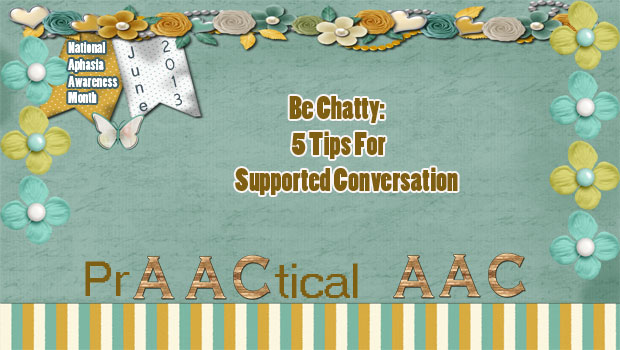
There are many strategies to support communication and conversation for individuals with significant aphasia. Conversation is about connecting with people. We engage in conversation about interesting and relevant experiences to help with connecting. To best connect and be part of conversation, there needs to be comprehension and expression from each communication partner. With aphasia, there is difficulty in these language areas, but it is not that language is lost, it is that it needs to be accessed differently. These quick start tips will support accessing conversation and connections. Write or Draw Key Words– When you are talking, write key words to support your spoken language. Gesture Key Words– When you are talking, supplement spoken language with gestures to illustrate a main point Show Related Photographs or Remnants– While you are talking, use photographs or some remnant of the an experience or event you are talking about. Written Choices to... [Read More...]
June 1, 2013
by Carole Zangari -
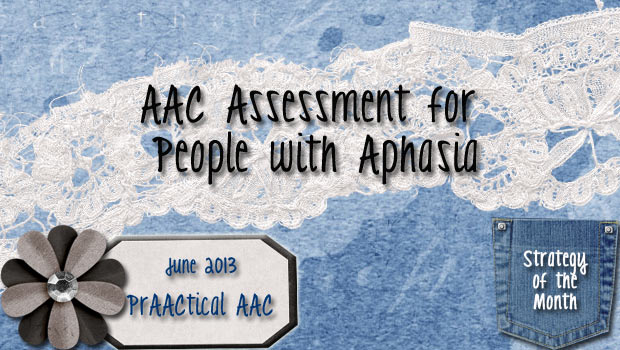
Many people with aphasia fail to regain sufficient speech and language skills to meet their communication needs. With more than one million people with aphasia in the US alone, chances are most people reading this know at least one person affected by the disorder. While many go on to regain functional speech and language skills, some remain unable to communicate well enough catch up with a neighbor, talk about bills with a spouse, ask a question in a store, play with a grandchild, or tell their healthcare providers about side effects or symptoms. It’s hard to really imagine how devastating and isolating this experience may be. Aphasia Awareness Month seemed like the perfect time to reach out to SLPs with information on AAC for people with aphasia. In this post, we’ll share some thoughts and resources on assessment. Assessment activities are, of course, driven by the purpose for which the... [Read More...]
May 18, 2013
by Carole Zangari -
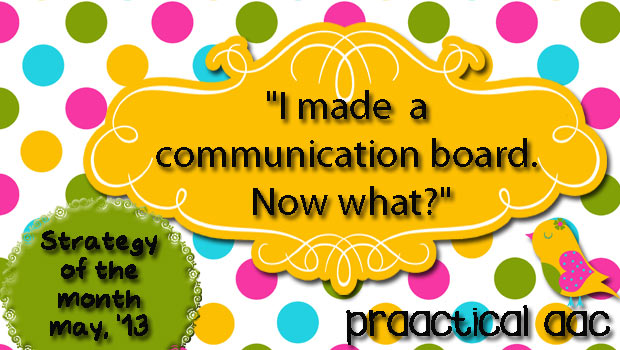
Earlier this month, we shared some ideas for making communication boards using color coding and also for creating boards geared to different communicative purposes. Making the communication board according to some basic principles is a good thing, of course, and it takes a decent amount of thought and planning. Even more important, though, is developing an intervention plan so that the augmentative communicator learns how to use the board effectively. Here are some of our thoughts on how to teach someone to use a new communication board. Model It We’ve talked about aided language input so many times that I’m almost embarrassed to mention it. Almost. The truth is, it is a ‘must do’ strategy when we’re first introducing a communication board, book, SGD, or AAC app. Incidental learning is important for just about all of the people with whom we work. It is never the only strategy we use,... [Read More...]
May 10, 2013
by Robin Parker -
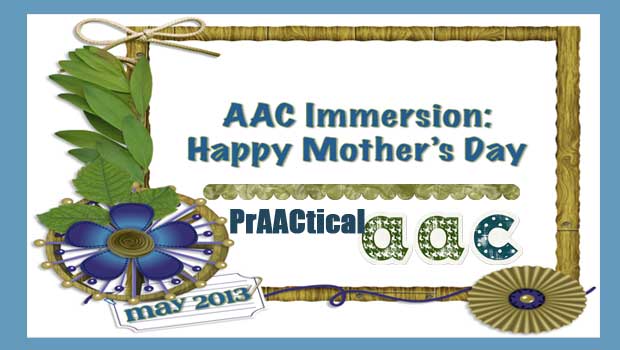
We were just having some in-depth conversations about AAC and making a difference. AAC intervention needs to be part of more than speech-language therapy. It needs to be a way of life, a communication and language interaction style, and fully immersed into all interactions. There are some Mom’s who make this happen. We have written about some of them in Getting From Here to There . But there are more (many more) and for awhile now some have been blogging about their AAC & visual language adventures. Here are just a 5 awesome posts from moms who share AAC rationales and meaningful AAC & language experiences. Learn from the best. Beach Trip (And AAC on the Road) by Dana Nieder– Uncommon Sense Halloween & AAC by Deanne Shoyer – Small But Kinda Mighty Her Eyes Shows She Knows by Catriona– Living With Rett Syndrome An Open Letter to the Parent of a Child with Speech... [Read More...]
May 6, 2013
by Carole Zangari -
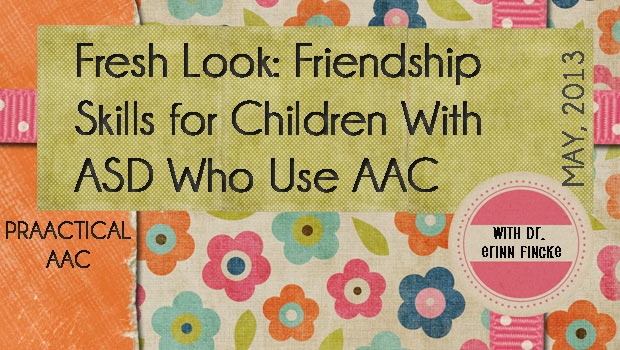
As we’ve said before on this blog, SLPs have great potential to make a difference in the social experiences of people who use AAC by supporting the development of friendships. ASHA’s Better Speech and Hearing Month (#BHSM) gives us a great opportunity to spread awareness that this is an area in which SLPs can make a tremendous difference. We’re so excited to share this Fresh Look post by Dr. Erinn Finke, Assistant Professor of Communication Sciences and Disorders at Penn State University. I was recently lucky enough to find myself in conversation with Pat Mirenda, a top researcher in the field of AAC and Autism Spectrum Disorders (ASD). In trying to decide what we really “know” about effective AAC strategies for children with ASD, we decided that while there is a lot of research regarding how to use AAC to teach children with ASD to request things, there really is not... [Read More...]
May 1, 2013
by Carole Zangari -
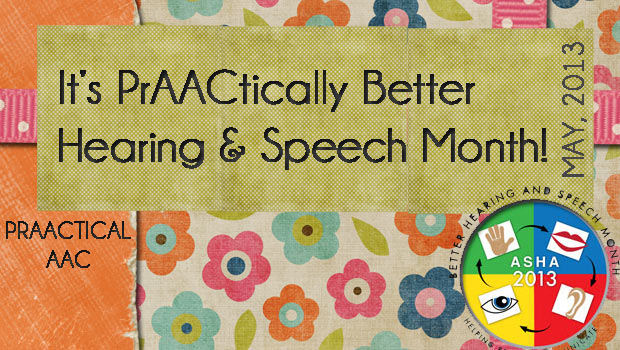
We’re celebrating ASHA’s Better Speech and Hearing Month with a series of posts for SLPs who are working with people who have significant communication difficulties and aren’t currently using AAC strategies. In these posts, we hope to give clinicians a fresh look and some prAACtical ideas about using AAC with a variety of clinical populations. We’ve invited well-respected authors, researchers, and clinicians to contribute to this series. We’re proud to kick-off a new series called Fresh Look with posts on using AAC with children and adults. Watch for posts on on a variety of topics, including: Using AAC to support people with dementia by Dr. Melanie Fried-Oken AAC in General Education with Dr. Joan Bruno Supporting the friendships of children with ASD by Dr. Erinn Fincke Providing initial AAC supports to people with ALS by Lisa Bardach Language therapy with children who use AAC by Drs. Cathy Binger and Jennifer... [Read More...]
April 18, 2013
by Carole Zangari -
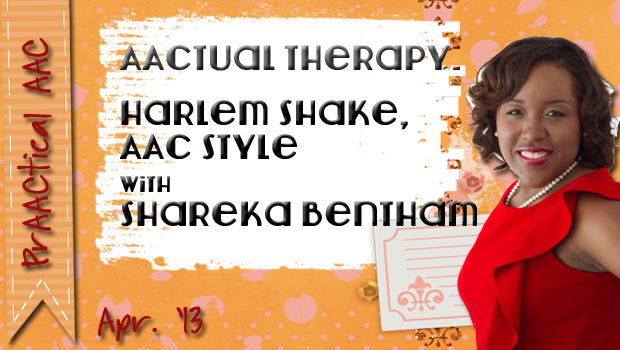
We’re back again with another AACtual Therapy post from SLP Shareka Bentham. We love the way she creates ‘buy in’ with kids, families, and teachers with this terrific activity. Everyone who knows me knows that I can get a little bit crazy sometimes, so when I went around school informing the teachers that we were going to be doing a school-wide Harlem Shake, no one was surprised. The thing is, my little ones, especially the school aged children are all very aware of the latest trends in popular culture (I have a little one that will only use his Big Mack to request Adele). Whether they are verbal or nonverbal, they can show you all the latest moves. So we just had to do Harlem shake. Well, a modified version… The main focus of the activity was making using AAC to make choices for the dress-up part of the activity.... [Read More...]
April 16, 2013
by Carole Zangari -
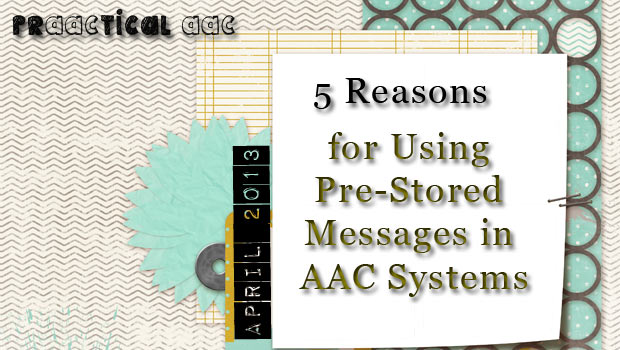
Although we are deeply invested in AAC systems that have a robust set of core language, that doesn’t mean we insist that our clients generate sentences word-by-word all the time. There are lots of good reasons for pre-storing longer messages. Here are some of them. Emergency messages: When we’re communicating about things like spasms, seizures, pain, medication, fear, and danger, time is of the essence. The quicker, the better. Examples: “My asthma is kicking up. Get my puffer, please.” “I’m having a back spasm. Take me out of my chair.” “I think my sugar is off. Can you do a finger prick to check my levels?” “I’m scared. Can you help me?” Partner instructions and communication transaction messages: Sometimes we communicate about communicating. In AAC, it’s not uncommon for someone to set the stage for how the interaction will proceed or provide their partner with specific directions. When communicating to... [Read More...]
April 12, 2013
by Carole Zangari -
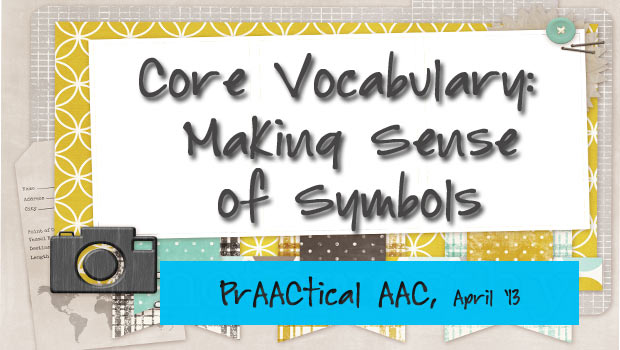
Take a look at these pictures and try to guess their meanings. Now do it again with these symbols. One more time with the symbols below. We’re not gamblers by nature, but if we had to bet we’d say that you had a pretty easy time guessing the first two rows (backpack, banana, bathroom; sleep, wash, eat) and struggled with the last row (know, she, was/were). That presents a bit of a problem, actually, because it’s that last hard-to-guess row that contains important core vocabulary. And these kinds of core words are the ones we need to use frequently during the day. Looks like we have a bit of a dilemma: The symbols that are least transparent are important ones to teach. We often hear SLPs say that they want concrete symbols for some of their clients with AAC needs. We can certainly make that happen for some... [Read More...]
April 6, 2013
by Carole Zangari -

Among the many changes that the AAC field has experienced in the last decade is the notion that core vocabulary is (or should be) an integral part of any AAC system. We grew to understand the limitations of AAC supports that consist primarily of nouns and descriptors, realizing that those kinds of communication displays restricted our clients to requesting and labeling. Our field realized the inadequacy of providing only prestored messages (e.g., limited the client’s ability to communicate anything novel, not flexible enough to meet most communication needs, etc.). In essence, we realized that without core vocabulary, we were imposing a ceiling on language development. We’re thrilled to see so many communication boards, books, SGDs, and AAC apps reflect this knowledge. Having tools with the appropriate vocabulary is a big step in the right direction. But to really shatter the ceiling of language development, we have to be good at... [Read More...]









